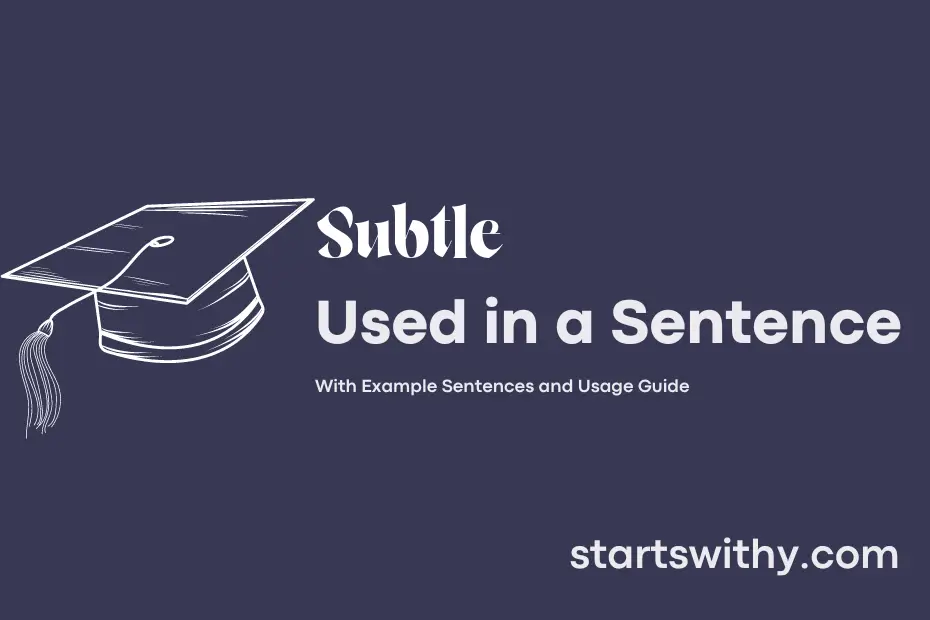Have you ever come across a sentence with a subtle message hidden within its words? The term “subtle” in language refers to something that is delicate, nuanced, or not immediately obvious. When used effectively, subtle language can convey deeper meanings or emotions without being overt or explicit.
In writing, a subtle sentence can add layers to a story, provoke thought, or evoke a particular mood in a reader. By incorporating subtle elements into their writing, authors can engage their audience on a deeper level and create a more immersive experience.
7 Examples Of Subtle Used In a Sentence For Kids
- The subtle colors of the butterfly’s wings made it hard to see.
- There was a subtle smell of flowers in the air.
- The cat moved with a subtle grace as it walked.
- The subtle sound of the wind rustling through the leaves could be heard.
- The subtle taste of the honey was sweet and delicious.
- The subtle changes in the weather signaled the arrival of a storm.
- The subtle patterns on the seashell were beautiful to look at.
14 Sentences with Subtle Examples
- The professor used subtle cues to hint at the importance of a certain topic for the upcoming exam.
- She made a subtle adjustment to her study schedule to accommodate the new project deadline.
- The student’s subtle nod during the group discussion showed his agreement with a classmate’s point.
- He added a subtle touch of humor to his presentation to keep his classmates engaged.
- The subtle change in font size helped highlight the key points in her research paper.
- The professor’s subtle reminder about referencing sources properly was a helpful nudge for the students.
- She noticed a subtle improvement in her grades after implementing a new study technique.
- The subtle shift in the discussions during the class debate revealed changing perspectives.
- He used subtle body language cues to convey confidence during his presentation.
- The professor’s subtle encouragement gave the students reassurance before their final exams.
- She made a subtle tweak to the group project outline for better organization.
- The subtle change in the assignment instructions required careful attention to detail.
- The subtle shift in the class dynamic was noticeable after the students completed a group project together.
- He noticed a subtle improvement in his understanding of the subject after attending the extra study sessions.
How To Use Subtle in Sentences?
To use Subtle in a sentence, start by identifying something that is not obvious or easily perceived. You can think of Subtle as something that is delicate, understated, or not immediately noticeable.
Here are a few examples of how you can use Subtle in a sentence:
- She noticed a subtle change in his tone, indicating that he was upset.
- The painting had a subtle beauty that grew on her the more she looked at it.
- His jokes often contained subtle references that only a few people caught.
- The subtle scent of lilacs filled the room, creating a peaceful atmosphere.
- The movie’s message was conveyed through subtle imagery rather than explicit dialogue.
When using Subtle in a sentence, it is important to pay attention to context and tone. Subtle can convey a sense of nuance or sophistication, so try to integrate it in a way that enhances the overall meaning of your sentence.
Remember, Subtle is about being understated and not drawing attention to itself, so try to use it in a way that adds depth or complexity to your sentence without overshadowing the main idea.
Conclusion
In conclusion, subtle sentences are those that convey meaning indirectly or with understated nuances. These sentences often require readers to infer or deduce the intended message, adding depth and complexity to the writing. By employing subtle sentences, writers can evoke emotions, create suspense, and engage the reader’s imagination more effectively.
Through the use of carefully crafted language and subtle techniques such as implication, suggestion, and ambiguity, writers can leave a lasting impact on the reader. Subtle sentences can invite readers to actively participate in interpreting the text, leading to a more immersive and thought-provoking reading experience. Mastering the art of crafting subtle sentences can elevate writing to a higher level of sophistication and artistry.



